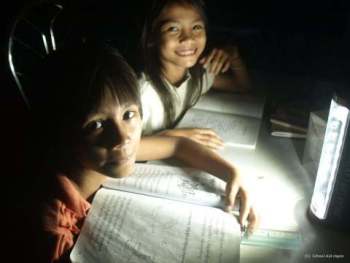Apr 6 2013
Panasonic Corporation (TOKYO:6752) deploys the 100 THOUSAND SOLAR LANTERN PROJECT, a project to donate a total of 100,000 solar lanterns to people in regions of the world without electricity, by 2018, the 100th anniversary of the company's founding.
 As Lights in the Study Room of the Orphanage (C)School Aid Japan (Photo: Business Wire)
As Lights in the Study Room of the Orphanage (C)School Aid Japan (Photo: Business Wire)
As the first stage in this effort, Panasonic donated 3,000 Compact Solar Lights (CSLs) to NGOs helping to solve social challenges in Myanmar in February 2013. In March 2013, Panasonic donated an additional 5,000 CSLs to NGOs and social enterprises in India, and then, plans to donate 2,000 CSLs*1 to refugees in Kenya.
About 100 THOUSAND SOLAR LANTERN PROJECT
Currently, there are about 1.32 billion people worldwide living without electricity, mainly in developing countries in Asia and Africa*2. Many homes in these regions use kerosene lamps for lighting, but they pose the risk of fire and the smoke released by them is harmful to human health. Since they do not provide sufficient light, activities of people are significantly restricted at night. The lack of electric light in these regions means challenges in the areas of healthcare, education and the economy.
To help solve these challenges, Panasonic has been promoting corporate citizenship projects by utilizing its core competence. In April 2011, Panasonic donated 1,000 solar lanterns to Tanzania through a UN agency, followed by 2,000 lanterns to Cambodia through 15 NGOs in March 2012. Thanks to the bright light of these lanterns, users can effectively carry out healthcare, education, and economic activities even at night without health risks. Some households have reported lower expenses since they do not have to buy kerosene.
Toward 2018, Panasonic will continue to donate solar lanterns to developing countries. The company is striving to help improve living conditions in these regions and to help achieve the UN Millennium Development Goals (MDGs).
*1 In fiscal 2013 (April 2012 - March 2013), the initial year of the project, Compact Solar Lights were donated instead of solar lanterns.
*2 Source: "World Energy Outlook 2011" International Energy Agency